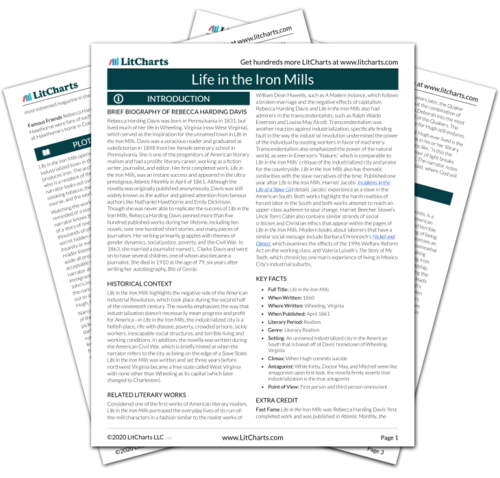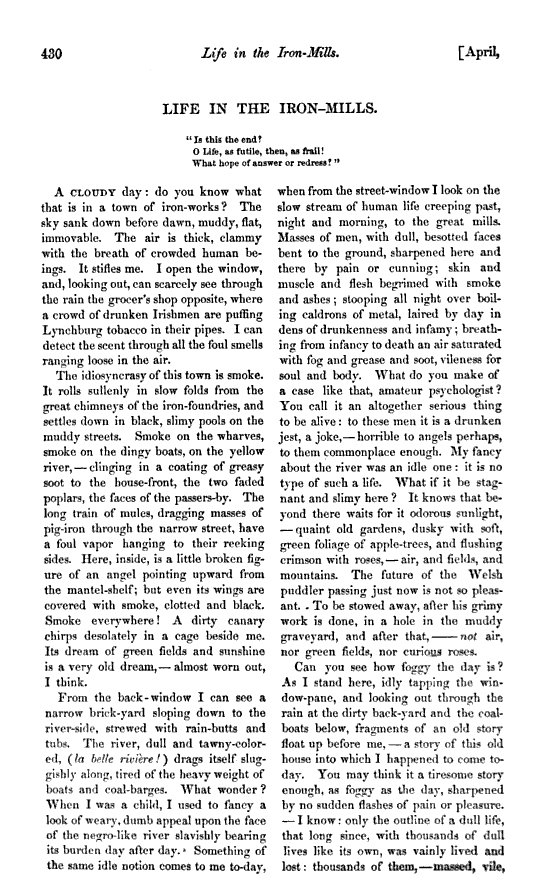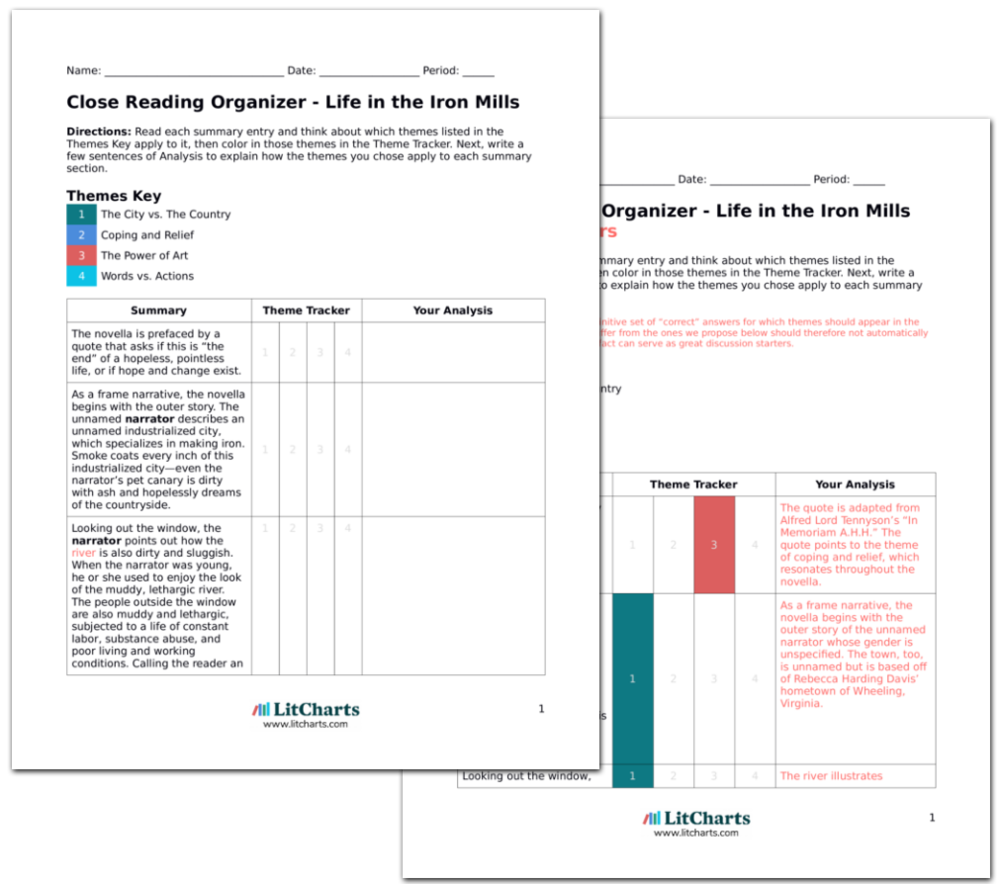life in the iron mills themes
She broke into the issue as a youthful woman in the 1860s with Life in the Iron Mills which established her as one of the founders of American Realism. 13 Life in the Iron Mills reworks Daviss struggles with the problems of thwarted vocation feminine longing and the alienation of an immigrant and in an allusion to a textile mill an.

Analysis Of Rebecca Harding Davis S Life In The Iron Mills Literary Theory And Criticism
The woman Deborah was like him.

. ENotes critical analyses help you gain a deeper understanding of Life in. She wore a faded cotton gown and a slouching bonnet. The unnamed narrator describes an unnamed industrialized city which specializes in making iron.
Life in the Iron Mills considers. This theme is developed through Daviss use of imagery and characterization and is best represented by two of the main characters Deborah and. People are definitely reliant on human interaction.
However for all its evocative documentation of. The subtitle or The Korl Woman relates to the female figure sculpted by one of the workers which represents the human yearning for worth. 2 pages at 400 words per page View a FREE sample.
Mitchell s links the slavery of the South directly to. From the late 1860s until her demise in 1910 Rebecca Harding Davis was one of the finest and well-known writers in America. Life in the Iron Mills is about a young man who is amazingly talented.
This young man can create a sculpture out of scrap metal that speaks to the person looking at it telling a story that no one can truly appreciate unless they have lived the emotion it represents. A stranger in the cityspending a couple of months in the borders of a Slave State to study the institutions of the Southa brother-in-law of Kirbys. Encouraging social reform for working class womenas well blacks and immigrantsDavis employs a harsh concrete description of poor living.
The novella carries a prominent theme of want and desire. It is the separation of classes when the people in theshow more content she continues on to describe that the mill is divided into by shifts a group of workers come in for a while and work and then another group comes in and relieves that group. A theme that was evidently a stable for the working farmers and also the Protagonists Lennie and George was the theme of brotherhood.
In this enlightening thesis of significant work I seek to. In Rebecca Harding Daviss novella Life in the Iron Mills select days of an iron mill worker are examined. The ultimate theme in Rebecca Davis Life in the Iron Mills is the separation of classes and gender.
Life in the Iron Mills mainly takes place within the city limits of an unnamed Southern mill. Her relation to this sculpture is in uneasy one. To further describe her subject Davis uses body markers such as.
Hugh leads a dismal life of constant labor and terrible living conditions and he. Life in the Iron Mills details the horrible working and living conditions that pervade industrialized. Smoke coats every inch of this industrialized cityeven the narrators pet canary is dirty with ash and hopelessly dreams of the countryside.
It is the separation of classes when the people in theshow more content. This section contains 450 words. The ultimate theme in rebecca davis life in the iron mills is the separation of classes and gender.
At the time of its first publication audiences assumed the unnamed author was male. Rebecca Harding Daviss story Life in the Iron Mills is considered one of the first fictional novels to use realism and bring to life a delineated lower class and issues relevant to women. Its graphic probe into ethnicity vocation and class also encompasses according to Pfaelzer what became Daviss most characteristic subject and theme.
Hugh Wolfe one of the novellas protagonists is a 32-year-old furnace-tender in an iron mill in the American South. It was first published anonymously in The Atlantic Monthly in 1861 and was later reprinted as a part of a story collection by The Feminist Press in 1985. Race gender and class identification and limited.
Discussion of themes and motifs in Rebecca Blaine Hardings Life in the Iron Mills. In the story both the 2 main characters Deborah and Hugh are exposed to these conditions that are imitated as hell and inferno sites. Life in the Iron Mills is novella packed with deeper meaning.
She continues on to describe that the mill is divided into by shifts a group of workers come in. First comes the revelation of the mystery man accompanying the recognizable figure of the son of the mills owner. Old Wolfe lay asleep on a heap of straw wrapped in a torn horse-blanket.
Life in the Iron Mills. At the end of the story the narrator reveals that she now owns Hugh Wolfes sculpture which led to his encounter with the four upper-class men touring the mill and indirectly to his prison sentence for theft. Unlike the more refined and decorous objects that sit in her home a half.
Brotherhood contributed to the novel in a sense that it created opportunities amongst men which society would deem impossible at the time. Bianca Chirinos Professor Karafilis English 3600 November 3 2017 Industrial Capitalism in Life in the Iron Mills In the novella Life in the Iron Mills by Rebecca Harding Davis an extraordinary compelling portrait is depicted of the 1830s powerless and tired labor class. Life In The Iron Mills Analysis.
Strong women and powerlessness. As a frame narrative the novella begins with the outer story. The korl woman is a hugely important symbol in Life in the Iron Mills symbolizing many things.
Life in the Iron Mills is a novella written by Rebecca Harding Davis. Only her face was even more ghastly her lips bluer her eyes more watery. While the novella shows romanticism naturalism and realism this essay is specifically centered around realism.
Life in the Iron Mills. Hugh explained that the woman was hungrily reaching out for something to. The title holds a certain verbal irony as Davis illustrates in the story that the puddlers who heat and stir iron in the iron mills are living such meager existences that they can barely be deemed living at all.
This Study Guide consists of approximately 27 pages of chapter summaries quotes character analysis themes and more - everything you need to sharpen your knowledge of Life in the Iron Mills and Other Stories. Life in the Iron-Mills an account of the squalid life blighted aspirations and aborted potential of the Welsh mill worker and primitive artist Hugh Wolfe is rightly celebrated as both a powerful indictment of unrestrained industrial capitalism and a superior example of the initial phase of American realism. He was a pale meek little man with a white face and red rabbit-eyes.
In the text written by Rebecca Harding Davis titled Life in the Iron Mills Rebecca incorporates the theme of oppression and hopelessness felt by the immigrants and workers that work in the harsh conditions of the iron mills and other factories. The City vs. Here are a few of the many important symbols and themes that occur throughout the story.

Life In The Iron Mills By Rebecca Harding Davis

Hand Pumps Hand Pump Windmill Life Skills

Pin By Ria Dimitra On Magical Home In 2022 Magical Home Whimsical Cottage Ecclectic Decor

Life In The Iron Mills By Rebecca Harding Davis

One Day In The Life Of Ivan Denisovich Study Guide Course Hero A Day In Life Life Study Guide

Life In The Iron Mills Wikiwand

Life In The Iron Mills Themes Litcharts

Summary Of Life In The Iron Mills

Life In The Iron Mills By Rebecca Harding Davis

Life In The Iron Mills By Rebecca Harding Davis

Life In The Iron Mills Literature Tv Tropes

Life In The Iron Mills Wikiwand

Life In The Iron Mills By Rebecca Harding Davis

Diesel House Copenhagen Denmark Dieselpunk Retro Futurism Old Trains




